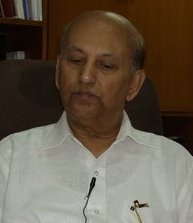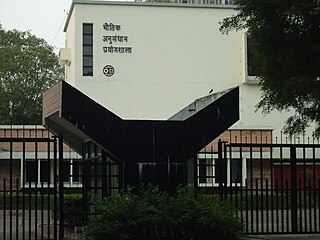Related Research Articles

ITER is an international nuclear fusion research and engineering megaproject aimed at creating energy through a fusion process similar to that of the Sun. Upon completion of construction of the main reactor and first plasma, planned for late 2025, it will be the world's largest magnetic confinement plasma physics experiment and the largest experimental tokamak nuclear fusion reactor. It is being built next to the Cadarache facility in southern France. ITER will be the largest of more than 100 fusion reactors built since the 1950s, with ten times the plasma volume of any other tokamak operating today.

Dr. Vikram Ambalal Sarabhai was an Indian physicist and astronomer who initiated space research and helped develop nuclear power in India. He was honoured with Padma Bhushan in 1966 and the Padma Vibhushan (posthumously) in 1972. He is internationally regarded as the Father of the Indian Space Program.
Predhiman Krishan Kaw was an Indian plasma physicist. He had been the founding director of the Institute for Plasma Research and served the institute as the director from 1986 to 2012.

Mambillikalathil Govind Kumar Menon also known as M. G. K. Menon, was a physicist and policy maker from India. He had a prominent role in the development of science and technology in India over four decades. One of his most important contributions was nurturing the Tata Institute of Fundamental Research, Mumbai, which his mentor Homi J. Bhabha founded in 1945.

Udupi Ramachandra Rao was an Indian space scientist and former chairman of the Indian Space Research Organisation. He was also the Chairman of the Governing Council of the Physical Research Laboratory at Ahmedabad and Nehru Planetarium at Bengaluru and chancellor of the Indian Institute for Space Science and Technology (IIST) at Thiruvananthapuram. He is known as "The Satellite Man of India". He pioneered India's first satellite launch Aryabhata in 1975.

The Physical Research Laboratory is a National Research Institute for space and allied sciences, supported mainly by Department of Space, Government of India. This research laboratory has ongoing research programmes in astronomy and astrophysics, atmospheric sciences and aeronomy, planetary and geosciences, Earth sciences, Solar System studies and theoretical physics. It also manages the Udaipur Solar Observatory and Mount Abu InfraRed Observatory. The PRL is located in Ahmedabad.

The Institute for Plasma Research (IPR) is an autonomous physics research institute in India. The institute is involved in research in aspects of plasma science including basic plasma physics, research on magnetically confined hot plasmas and plasma technologies for industrial applications. It is a large and leading plasma physics organization in India. The institute is mainly funded by the Department of Atomic Energy. IPR is playing a major scientific and technical role in Indian partnership in the international fusion energy initiative ITER. It is part of the IndiGO consortium for research on gravitational waves.

Thirumalachari Ramasami is a former Indian Science and Technology Secretary. He assumed charge in May 2006. Prior to this assignment, he served as the Director of the Central Leather Research Institute, Chennai, India. He is a distinguished researcher and leather scientist. He was awarded India's National Civilian Honour the Padma Shri for excellence in Science and Engineering in 2001 and the Padma Bhushan in 2014. He was awarded the Shanti Swarup Bhatnagar Award, the highest award for science in India, for notable and outstanding research in Chemical Sciences in 1993.
Satya Prakash is an Indian plasma physicist and a former senior professor at the Physical Research Laboratory. He is known for his studies on Langmuir probes and other contributions in space and plasma sciences. A protégé of Vikram Sarabhai, Satya Prakash is an elected fellow of all the three major Indian science academies such as Indian Academy of Sciences, Indian National Science Academy and National Academy of Sciences, India as well as the Gujarat Science Academy and is a recipient of the Hari Om Ashram Prerit Senior Scientist Award. The Government of India honored him with Padma Shri, the fourth highest Indian civilian award for his contributions to the discipline of Physics, in 1982.
Nautam Bhagwanlal Bhatt was an Indian physicist born in Jamnagar, Gujarat. He was the founding Director Solid State Physics Laboratory, Delhi. Nautam was a recipient of Padma Shri Award for his contributions to "Science and Engineering".
SST-1 is a plasma confinement experimental device in the Institute for Plasma Research (IPR), an autonomous research institute under Department of Atomic Energy, India. It belongs to a new generation of tokamaks with the major objective being steady state operation of an advanced configuration plasma. It has been designed as a medium-sized tokamak with superconducting magnets.

Anil Kumar Gupta is an Indian scholar in the area of grassroots innovations. He is the founder of the Honey Bee Network. He retired as a full-time professor at the Indian Institute of Management, Ahmedabad in 2017, where he served for about 36 years.

George Joseph is an Indian space scientist, best known for his contributions to the development of remote sensing technology in India, especially in the field of earth observation sensors. He is a former chairman of the Lunar Mission Study Task Force of the Indian Space Research Organization and an elected fellow of the National Academy of Sciences, India, Indian Academy of Sciences and Indian National Academy of Engineering. The Government of India awarded him the Padma Bhushan, the third highest civilian award, in 1999.
Mahendra Singh Sodha, popularly known as M. S. Sodha, is an Indian physicist specialising in Plasma, Optics and Energy and a former vice chancellor of Lucknow University, Devi Ahilya University and Barkatullah University. A 1974 winner of the highest Indian science award, Shanti Swarup Bhatnagar Prize, Sodha was honoured by the Government of India again in 2003 with Padma Shri, the fourth highest Indian civilian award.

Valangiman Subramanian Ramamurthy is an Indian nuclear physicist with a broad range of contributions from basic research to Science and Engineering administration.Prof.Ramamurthy started his career in Bhabha Atomic Research Centre, Mumbai in the year 1963. He made important research contributions in the area of nuclear fission, medium energy heavy ion reactions, statistical and thermodynamic properties of nuclei and low energy accelerator applications. During the period 1995-2006, Prof.Ramamurthy was fully involved in Science administration as Secretary to Government of India, Department of Science and Technology, (DST), New Delhi.Other important assignments held by him include Director, Institute of Physics, Bhubaneswar, (1989-1995), DAE Homi Bhabha Chair in the Inter-University Accelerator Centre, New Delhi (2006-2010), and Director of the National Institute of Advanced Studies, Bengaluru (2009-2014). He is a former chairman of the Recruitment and Assessment Board of the Council of Scientific and Industrial Research and has served as a member of the design team of the first Indian nuclear experiment in Pokhran on 18 May 1974. The Government of India awarded him the third highest Indian civilian honour of Padma Bhushan in 2005.
Paranandi Venkata Suryanarayana Rao is an Indian computer scientist, known for his researches in the fields of speech and script recognition and is credited with contributions for the development of TIFRAC, the first indigenously developed electronic computer in India. He is a recipient of awards such as IEEE Third Millenium Medal, Vikram Sarabhai Award, Om Prakash Bhasin Award and VASVIK Industrial Research Award. The Government of India awarded him the fourth highest civilian honour of Padma Shri in 1987.
Maneklal Sankalchand Thacker (1904–1998) was an Indian power engineer, academic and the director general of the Council of Scientific and Industrial Research, the largest research and development organization in India. He served as a secretary at the Ministry of Scientific Research and Cultural Affairs (1957–62) and sat in the Planning Commission of India as a member from 1962 to 1967. He was an elected fellow of the Indian Academy of Sciences and the Indian National Science Academy. The Government of India awarded him the third highest civilian honour of the Padma Bhushan, in 1955, for his contributions to literature and science education.
Amita Das is an Indian plasma physicist. She is currently a professor at the Indian Institute of Technology Delhi. Her research interests are in laser-plasma interactions, nonlinear plasmas, plasma turbulence and the properties of strongly coupled and dusty plasma systems.
Dhiraj Bora was an Indian physicist, educationist and professor. Bora, known as a plasma scientist, was a former director of the Institute of Plasma Research located in Gandhinagar, Gujarat. He was the chief scientist of the ITER – India. He won the Kamal Kumari National Award in 2012 in recognition of his contribution to the field of science. In 2016 he was elected as the vice-chancellor of Assam Science and Technology University and held the post until his death. He died on 19 June 2021.
Abhijit Sen is Emeritus Scientist and INSA fellow,Sr. Professor, Institute for Plasma Research, Chandrasekhar Chair.
References
- ↑ Sabina Griffith (February 2010). "Who says science doesn't fuse with poetry?". iter newsline (#117).
{{cite journal}}: External link in|journal= - ↑ "Padma Awards" (PDF). Ministry of Home Affairs, Government of India. 2015. Retrieved 21 July 2015.